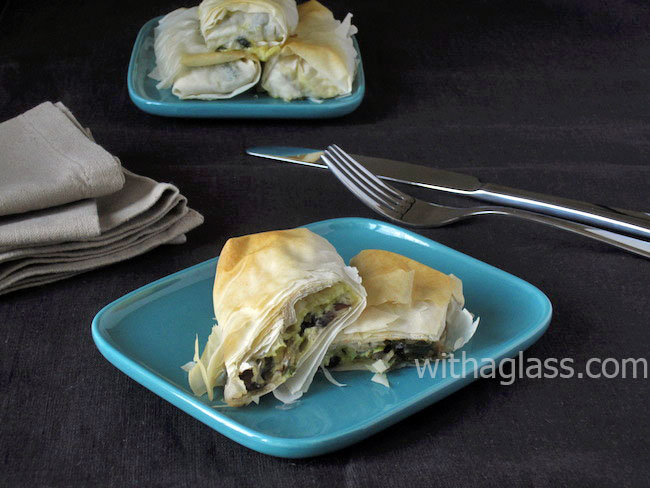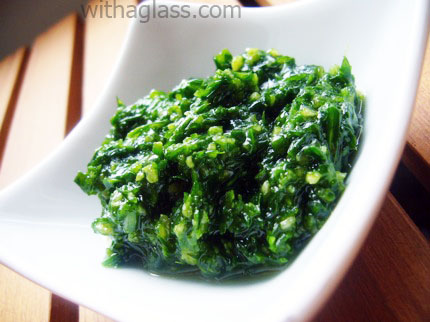Mock Spanakopita Rolls with Wild Garlic (Filo Rolls with Feta and Wild Garlic)

Greek spinach or spinach and feta pie is one of the rare vegetarian dishes I am truly fond of. I have recently discovered it tastes even better if made with baby spinach. Since its season corresponds to wild garlic’s, I simply changed the leaves and made a mock garlicky spanakopita (or rather mock spanakotiropita, as I learnt from Katerina). I don’t know if wild garlic is popular in Greece and whether my Greek visitors would approve of such a modification, but for a garlic fan like me these strong-flavoured snacks were a sensational discovery. Wild garlic and feta proved to be perfect companions and the flavours were so complex, no one would ever believe the filling includes only four ingredients with ground pepper as the sole seasoning.

If you have never heard about wild garlic (Allium ursinum), also called ramsons, ramps or bear’s garlic, it’s a plant growing in the forest or nearby with long wide leaves (see above, but Wikipedia should have better photographs), which are unfortunately similar to toxic lily of the valley leaves. An olfactory test is however a very easy method avoiding confusion: wild garlic smells of… garlic and the aroma is really strong. In Europe wild garlic’s season lasts at least from April to May (sometimes it stretches, depending on the temperature and the region), so it’s quite short. I don’t know if it can be grown, but I have never heard about cultivated plants, so consumers are limited to this very short period.
Wild garlic grows in many European countries, but strangely it’s not popular everywhere (unfortunately there are countries where it’s a protected plant and picking is forbidden, so check your country’s regulations before foraging). It is usually used in warm dishes (cooked, fried, baked, etc.) or mixed (such as in the below pesto I posted). I have never tried freezing it, but it dries very well and keeps its wonderful aroma. The dried form can be used as seasoning in many dishes; for example in Switzerland, where wild garlic is very popular, a supermarket chain has recently started to sell sausages seasoned with dried wild garlic and I find it an excellent idea.
I have adapted here the fresh and unique spanakopita recipe from Katerina’s Culinary Flavours, a beautifully written blog, full of inspiring dishes and featuring not only Greek cuisine. The process of squashing spinach instead of cooking it is an extremely ingenious idea I discovered at Katerina’s blog. As well ass adding cracked wheat to absorb humidity. I have been using both with real spanakopita and I have also practiced it here with wild garlic (obviously with equally satisfactory results).
If you get hold of fresh wild garlic and wonder what to do with it, here are some suggestions:



TIP: Most of you have eaten feta many times, but have you ever had feta made with both sheep and goat milk? (Most of feta is made with sheep’s milk). According to Wikipedia such a cheese can still bear “feta” name and the Greek sheep & goat milk feta I buy is the best I have ever had. I strongly encourage you to taste such a variety of feta if you find it.
Preparation: about 1 hour
Ingredients (makes 6 rolls):
6 sheets of filo pastry
200 g feta cheese, crumbled
1 egg
2 big handfuls of chopped wild garlic leaves (with or without stalks)
1 flat tablespoon cracked wheat (you can use semolina instead, but I prefer cracked wheat)
black pepper
Preheat the oven to 180°C.
Put the chopped wild garlic leaves into a bowl and squash them with your hands until the volume is reduced. Crumble the drained feta into a bowl. Add the chopped wild garlic, cracked wheat and some ground black pepper, stir well and with a spoon divide into 6 equal portions (this will make the filo sheets filling process much easier).
Spread one filo sheet on a big chopping board.
Place horizontally, about 2,5 cm/1 in. from the filo sheet’s shorter edge which is closest to you, a portion of feta and wild garlic mixture.
Roll tightly but delicately, starting from the edge which is closest to you, folding the two lateral edges into the roll, so that the filling doesn’t leak during the baking process (I have folded here about 3 cm/about 1,2 inch on each side).
Proceed in the same way with the remaining rolls.
Brush the top of the rolls with some oil or melted butter, place on a baking tray or baking paper and bake in the oven until slightly golden (about 30 minutes in mine). Watch them often as they tend to burn quite quickly.
This is why I love blogging, I learn something new each and every time. I’ve never had wild garlic but am quite enthralled now thanks to your post. I do make spanakopita and am curious about not cooking the leaves but squashing them, I bet it allows the subtle spinach flavour to sing. It’s unfortunate that in Canada we allow Canadian cheese makers to make feta and call it Greek feta; it has only salty flavour and the texture is hard and dry and not at all creamy like real Greek feta should be. We have found a true Greek brand but it’s difficult to come by. Next time I shall check if it’s both sheep and goat milk.
Thank you, Eva. You should check Katerina’s raw spinach method. Fabulous! It tastes more fresh than spanakopita with cooked spinach. Luckily in Europe producers have no right to call “feta” products from outside of Greece. At best, they can call their cheese “feta-style” or something like this. If you like goat cheese, you will love this sheep & goat feta. (I buy it in my organic shop, so maybe you will find it in an organic shop too?).
Creamy feta and spinach is one of my favourite fillings for phyllo but the wild garlic sounds like a great addition as well.
Thank you so much, A_Boleyn.
The combination of feta cheese and wild garlic just sound and look delicious…especially wrapped in a thin and crispy filo pastry.
Have a great week Sissi 🙂
Thanks a lot, Juliana. I’m glad you like the idea.
Thank you so much for all the kind words about me and blog Sissi! Your generosity has really no limits! I am not a food puritan and I love all the tweaks on the original as long as it is mentioned as here. Besides, that is all food blogging is all about taking local food one step further. I am sure this spanakopita will have a very bod taste due to wild garlic and I wish I lived close so I could try a piece or maybe two haha! When it comes to spanakopita I cannot stop to one. Now that I come to think about it, it is better that I don’t live close, I could eat the whole pan haha! Again big thanks!
Dear Katerina, thank you so much for such kind words. This is my who is most grateful to you for the interest and love for Greek food you have given me with your fascinating blog (not to mention your extraordinary uncooked chocolate terrine/marquise which is already a beloved staple in my house). I’m glad you approve of this modification. I really loved it. Thank you for this kind comment and warm words again.
I never realised picking it in some countries was forbidden. Interesting news. I will keep in mind, not that I will recognise it if I see it:)
I think it smells garlic so much, you’ll notice it by the scent at least, especially since it grows in big groups 🙂
looks delish!!!
i’m on hunt for wild garlic now….
Thank you, Dedy.
“Greek spinach or spinach and feta pie is one of the rare vegetarian dishes I am truly fond of” — Oh, that brought me the biggest smile (love the frankness! 😉 ). Sissi…. I read your post as soon as it came in and I should have responded right off the bat as I got derailed mid-week — but here I am. Love what you’ve done here bringing in the wild garlic and cracked wheat to your delightful spanakopita — I suspect the garlic brings these little bundles to a whole new level of taste and deliciousness; such a good idea. I have to tell you that the only reason I know about ramps is because one of my dearest blogging buddies forages for ramps in the wild! (I refer to her affectionately as ‘pioneer woman’) — she is truly amazing and I have to introduce you to her… I hope you don’t mind (she is heavily into preserves too so I think you’re a match made in heaven :D) — you could start by checking out this post: http://www.kitchen-apparel.com/2/post/2013/04/foraging-for-ramps-in-new-jersey.html — hope you enjoy! xx
Thank you so much, Kelly. I’m a big big animal eater. It can be even a humble squid or even a bit of canned anchovies on my pizza, but some animal flesh is what I crave in most of my dishes 😉 I was already like this as a child… Mushrooms and eggs are also ok, but frankly cheese only… it’s still a big surprise for me! The cracked wheat (Katerina’s fantastic idea) is such a wise thing to do… Filo pastry is much less soggy. Such an amount is hardly discernible, but it plays a big role actually. (Especially in the big “proper” spanakopita). Here in Switzerland ramps are very popular actually. Before moving here I knew what wild garlic looked like, but have never tasted it…. here even supermarkets sometimes sell it, not to mention farmers markets. Obviously many people forage it too. This year I even saw a supermarket’s brand selling sausages with wild garlic! (Oh, I think I have written it in the post…). Thank you so much for the link. I’m looking forward to meeting your blogging friend!
I am more than ready to try some fresh wild garlic. The dried that you sent me is wonderful with eggs. I also put some on a grilled cheese the other day with excellent results! Now I’m waiting for the weather to warm so I can plant those seeds you sent. When I read that it likes a shady spot I knew that it’s perfect for the beds in the front of my house which faces northeast. Once I get some growing, I’ll know where to come to get some recipes. 🙂 Spanakopita is such a wonderful treat and one that I always purchase. Sounds like it’s time for me to try making it at home. Thanks Sissi!
Thank you so much, MJ. I’m glad you enjoy the dried wild garlic (I can send you some more if you want! just give me a sign). You have been really creative with it! Actually the seeds are not wild garlic; they are chives garlic seeds (“nira” in Japanese), so they look a bit like thick flat chives and have a wonderful garlicky smell! I’m sure you can use them in any dish (I see them like a substitution of chives/green onions and “normal” garlic), not only Asian. I don’t think it’s possible to sow wild garlic… though a visitor has kindly told me she grows it in her garden (from bulbs, I guess). PS I think chile pequin seeds are sprouting!!!! I wonder how my experiment will end…